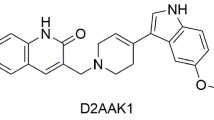Summary.
Pramipexole and several other dopamine agonists have been recently demonstrated to have neuroprotective effects in vitro and in vivo. We report here that pramipexole can protect DAergic cell line MES 23.5 against dopamine (DA), 6-hydroxydopamine (6-OHDA), and hydrogen peroxide (H2O2)-induced cytotoxicity in vitro possibly through antioxidant effects, and such neuroprotection could not be blocked by selective D2 or D3 antagonists. Incubation with pramipexole (5–20 μM) in MES 23.5 cell cultures increased cellular levels of glutathione (GSH), and elevated glutathione peroxidase (GSH-Px) and catalase activities, but only marginally enhanced SOD activity. Pretreatment with D2 or D3 antagonists did not block the stimulating effects of pramipexole on the cellular levels of GSH, and on the activities of GSH-Px and catalase in MES 23.5 cells. These results indicate that pramipexole's neuroprotective effects are likely associated with its antioxidant property independent of D2/D3 receptor activation.
Similar content being viewed by others
Author information
Authors and Affiliations
Additional information
Received December 13, 1999; accepted February 25, 2000
Rights and permissions
About this article
Cite this article
Le, W., Jankovic, J., Xie, W. et al. Antioxidant property of pramipexole independent of dopamine receptor activation in neuroprotection. J Neural Transm 107, 1165–1173 (2000). https://doi.org/10.1007/s007020070030
Issue Date:
DOI: https://doi.org/10.1007/s007020070030




